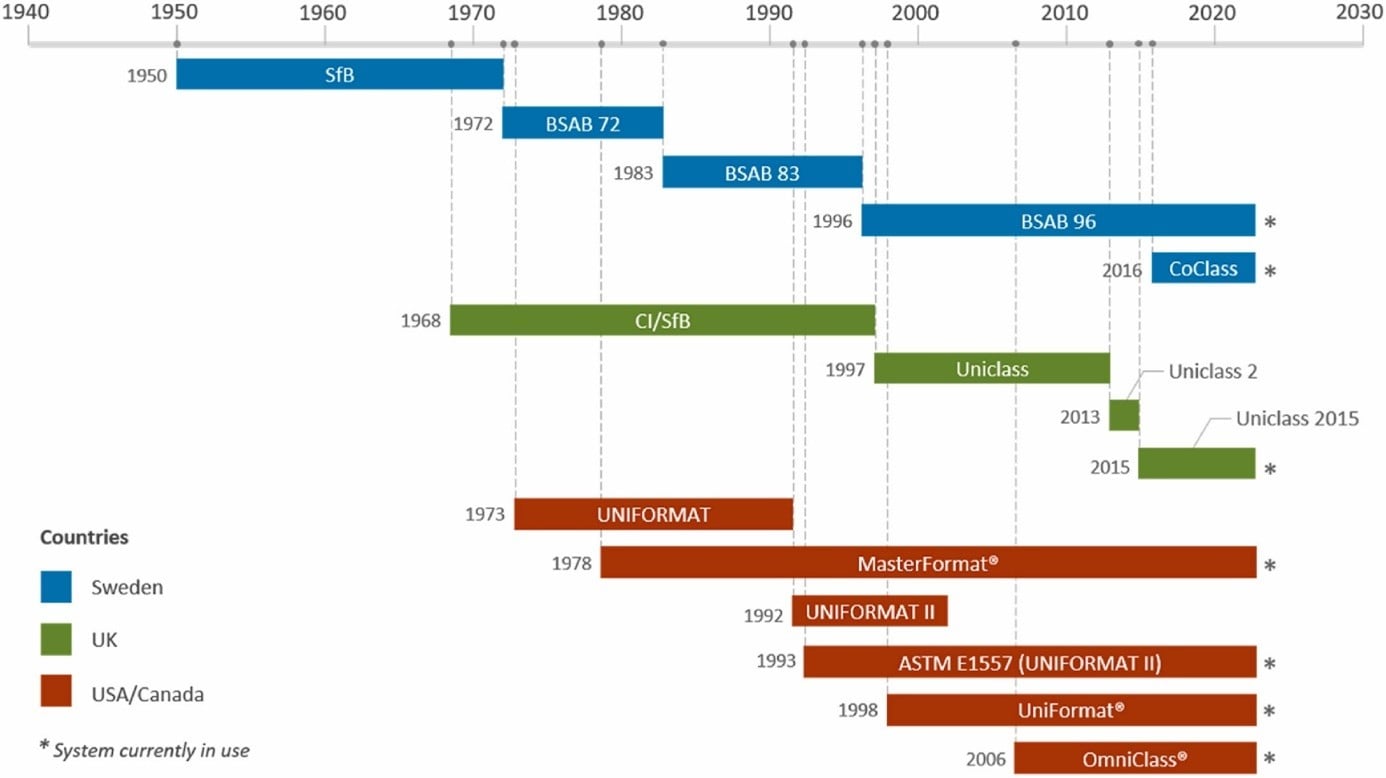Why Standardized Classification Systems Are Essential for Effective Construction Management
What can go wrong in the execution of a project where all stakeholders speak their own languages? If we visit any construction site in Europe today, we will notice a significant number of imported workers who speak little or no local language. Still, projects mostly progress within set parameters, and the key role is played by mediators (foremen, site managers) who can competently translate the local language of the designers into the language of the on-site workers.
Table of Content
- Standardization as a Common Language
- Real Consequences of Low Control and Lack of Standards
- What Happens When the System Fails?
- Classification as a Pillar of International Cooperation
- Standardization Supported by the Right Software
- Best Practice Examples and Differences Between Classification Systems
- The Role of Standardization in Information Management
- Benefits of Combining Standardization with Digital Tools
- Specific Features and Advantages of Global Classification Systems
- Conclusion
Standardization as a Common Language
An analogy to the mentioned mediators in the overall management and construction process is the standardized classification system for the construction industry. Such a system allows for the hierarchical organization of information and enables all project stakeholders to manage and exchange project information in a universally understandable way. Does that sound overly administrative, perhaps even boring—something that determines the quality of critical infrastructure or the quality of life in a constructed building?
Real Consequences of Low Control and Lack of Standards
Only one building in Bangkok collapsed during the earthquake that struck Myanmar on March 28, 2025, hundreds of miles away. Workers said the Chinese developer used low-quality materials during construction in an effort to cut costs. Among a range of other oversights, Thai officials testing the bent metal from the ruins said they found non-standard steel bars—produced in a Thai factory owned by Chinese interests, which authorities had shut down in December. The company, part of the consortium that built the building, underpaid contractors who then turned to lower-quality materials and used narrower columns than usual. Designers placed the reinforced concrete core off-center—unlike the standard American seismic construction code applied in Thailand.
Another branch of China Railway Group behind the project in Thailand was also responsible for the tragedy in Serbia in 2024, where a lack of quality control was likewise noted. There, an engineer working on the collapsed train station said the contractor hired by the Chinese consortium ignored the design specifications and added extra concrete to the roof canopy.
One could say such developments are an inevitable product of a corrupt environment. On the other hand, highly standardized systems with high-quality classification of construction services and mandatory implementation at all levels ensure a multi-layered mechanism of quality control and leave less room for malpractice that results in cases like those mentioned.
Large-scale EU infrastructure projects—such as oil pipelines, gas pipelines, roads, or railways—often require the use of standard classification systems to manage complex data and ensure seamless cooperation among different project stakeholders. Despite the clear lack of a unified European classification system for construction and maintenance services, the existence of national standards applicable to all stakeholders within a country—such as Uniclass in the UK, Cuneco CCS in Denmark, DIN 276 in Germany—currently ensures understanding and exchange of information among all project participants, facilitating easier management and quality control.
The need for a quality, standardized classification system for project information, whether it concerns construction or maintenance (as discussed below), is well illustrated by another case with fatal consequences—the collapse of part of the Ronan Point residential building in London in 1968. The quality controller, in his incident report, emphasized the dangers caused by pressure on the walls from explosion, wind, or fire, determining that although the project met current regulations, a series of recommendations needed to be applied. The Ronan Point case offers an example of the importance, complexity, and level of detail that a unified classification system for the construction industry must encompass:
- Notify the gas authority about new gas installations
- Structural assessment for all blocks over six stories
- Consider studies on the frequency and duration of high wind speeds during design
- Consider the effects of fire on structural behavior during design
- Improve ventilation in high-rise blocks
- Revise regulations for the storage of explosive materials in high-rise blocks
- Design new high-rise buildings to prevent progressive collapse
- Reinforce high-rise buildings

What Happens When the System Fails?
The lack of standardized classification systems can lead to inefficiency and project failure, such as the Västlänken Project in Gothenburg, Sweden, which included the construction of a new railway tunnel to improve transport efficiency and connectivity. Before implementing the CoClass classification, the project faced several challenges:
- The previous classification system, BSAB 96, had limitations that led to poor communication among stakeholders.
- BSAB 96 did not effectively support the entire project lifecycle, causing difficulties in information management and activity coordination
- The older classification system was not developed for integration with modern technology, leading to inefficiencies in data management and project execution
- There were frequent misunderstandings and misinterpretations of project requirements and specifications
- Ineffective information management and coordination led to delays and increased costs, affecting the overall project success
- The lack of a unified classification system resulted in inconsistent documentation and quality control, which impacted project outcomes
The Västlänken Project highlights the importance of using standardized classification systems such as CoClass, which helped reduce or completely avoid the aforementioned problems.
Classification as a Pillar of International Cooperation
In larger project offices operating in the international market and responsible for project preparation and implementation, we often find dozens of employees whose job is to transpose data from various project stakeholders at different stages so that everyone speaks the same language—ideally, the locally accepted standard classification system.
Standardization Supported by the Right Software
Ultimately, it is crucial to have appropriate software solutions that, using a standard classification system, allow for practical and cost-effective management and exchange of information among all project stakeholders—especially investors, who must ensure lifecycle asset management from the design phase to the end of its service life, as supported by FieldWork 4.

Best Practice Examples and Differences Between Classification Systems
Below, we present examples of successful classification system implementations across various sectors, how a comprehensive classification system is used in construction and asset management industries, and why having a standardized way of organizing and managing information is essential for all stakeholders throughout different project phases — from design and construction to operation and maintenance.
There are several classification systems currently in use at the European level in the construction industry, each with its own strengths and areas of application. Here, we provide a comparison of some of the most prominent systems.
The Role of Standardization in Information Management
Standardizing project information — such as construction and maintenance activities, data formats, building functional units, entities, spaces and locations, internal systems, products, tools and machinery, and project roles — brings numerous benefits. The implementation of a unified classification system that helps standardize how information is organized and managed across all projects improves communication and collaboration among different stakeholders.
For large infrastructure managers, such as those overseeing roads and railways and handling massive volumes of asset-related information, the use of a structured classification system facilitates data management, processing, and sharing.
Benefits of Combining Standardization with Digital Tools
Applying standardization in combination with digital tools for planning, information exchange, and construction and maintenance management leads to increased organizational efficiency — a fact recognized not only by investors but also by major design offices and developers. While large infrastructure managers turn to standardization as the only sustainable way of operating, contractors tend to adapt to standardization only when it becomes a mandatory requirement for providing services to large public-sector asset managers.
Drawing lessons from past experiences and incidents — such as the Ronan Point collapse mentioned in the introduction — the UK has taken the lead in implementing standardized classification and now requires the use of the Uniclass standard in projects via Building Information Modeling (BIM), as stipulated in ISO 19650-1:2018. This ensures that projects meet high standards of quality and construction safety.
Uniclass can classify items of any size, from large assets such as railways to individual products like smart lighting fixtures. Thanks to its versatility, it has gained wider recognition and is applicable across a broad range of projects.
ISO 19650-1:2018 defines information management for buildings and civil engineering works when using BIM. It provides recommendations for managing information, including exchange, recording, versioning, and structuring, and is intended to be used by everyone involved in an asset’s lifecycle. Regarding information quality requirements, ISO 19650-1 states that item classification must follow the principles of ISO 12006-2, and that information about items must comply with ISO 12006-3 to enable proper data exchange. Part three of ISO 12006 specifies a taxonomy model that allows for referencing classification systems, data, objects, and process models within a common framework.[1]
In the context of today’s ubiquitous artificial intelligence, a common language and standardized approach facilitates better internal management and better collaboration with other organizations, which is crucial for structuring large amounts of data so that it can be used for the application of AI tools.
Specific Features and Advantages of Global Classification Systems
In addition to Uniclass, several other classification systems are recognized globally, such as:
- OmniClass, developed and used in North America. The system consists of multiple tables and is very similar to Uniclass. It covers aspects such as built entities, spaces, elements, and products, and crucially supports BIM-based information management.
- Cuneco Classification System (CCS), primarily used in Denmark where it was developed to increase productivity in the construction industry. However, its principles and methodologies are gaining international recognition and can be adapted for use in other countries. CCS is especially valuable in projects that demand a high level of digital collaboration and information exchange, such as those involving BIM. It ensures that all stakeholders — from designers to contractors — use a common language and standardized data formats.
- CoClass, developed in Sweden, is designed specifically for asset management. It focuses on lifecycle information management where standardized classes, terms, and concepts create conditions for seamless information flow through all project phases. This means that an asset has the same meaning to all parties throughout its lifecycle. One of the biggest barriers to broader adoption is that CoClass is still not fully translated into English.
Each system has its own unique characteristics and is suited to different aspects of construction information management. Uniclass stands out for its versatility and comprehensive coverage, making it particularly useful for BIM projects.
It is also worth noting that Uniclass is the only system that offers free access to all of its classification data, which we found particularly useful when uploading and updating classification items within FieldWork 4.

You can learn more about the development of standardization and an in-depth comparative analysis of the classification systems from Sweden, the United Kingdom, and the US/Canada in an excellent academic paper available here. In this article, however, we aim to focus on the practical application and the business value that classification systems bring — both in general terms and through specific business use cases.
Conclusion
Although classification systems in the construction industry may seem like a complex topic reserved for technical experts, their application is essential for clarity, efficiency, and better collaboration among all stakeholders. That’s precisely why FieldWork is designed to support this approach — through its functionality and structured field data workflows.
In our next blog post, From Theory to Practice: What Major Projects Teach Us About Classification Standards and How to Start, we’ll shift the focus to the practical implementation of classification systems and explore the business benefits they deliver — both generally and through real-world examples. We’ll look at how structured data can simplify decision-making, boost efficiency, and deliver real value in day-to-day operations — at every stage of a construction project or asset management lifecycle.
Want to talk to us about your business needs?

Marin Curavić
Share
More from ASEE
Türk Ticaret Bank Selects ASEE InACT® External Fraud Prevention
Türk Ticaret Bank, Türkiye’s first privately established commercial bank
Garanti BBVA International Boosts Fraud Protection with ASEE InACT®
Garanti BBVA International, a provider of corporate banking, trade
SWIFT & SEPA Projects Successfully Delivered in Serbia and Montenegro
ASEE has successfully executed a series of complex regulatory initiatives across









